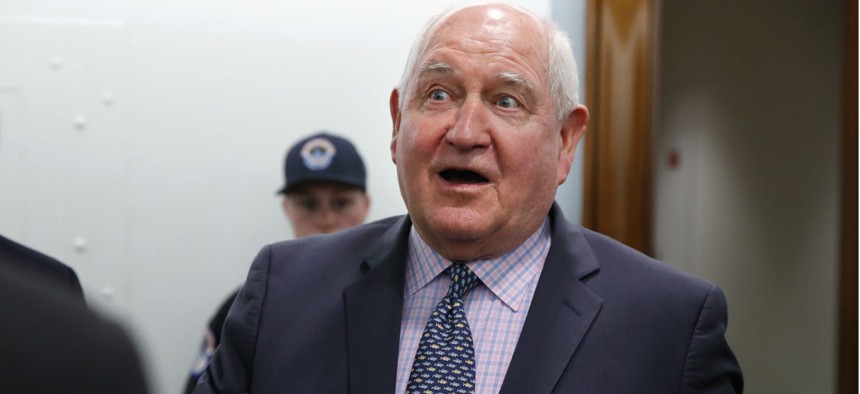
Agriculture Secretary Sonny Perdue speaks with reporters in April after testifying on the department's fiscal 2019 budget. Jacquelyn Martin/AP
How USDA Will Bypass Congress to Give Farmers $12 Billion in Emergency Aid
Budget analysts consider the Trump plan unusual.
As the Trump administration continues its zigzag policy of imposing new tariffs, the Agriculture Department has asserted its authority—without Congress—to route $12 billion from emergency crop support funds to help farmers harmed by trade practices.
Though the move announced on Tuesday is opposed by many farm-state lawmakers and farm advocates, budget experts see the plan as unusual, but permissible.
“This is a short-term solution to allow President Trump time to work on long-term trade deals to benefit agriculture and the entire U.S. economy,” said Agriculture Secretary Sonny Perdue in a statement explaining the goal of assisting farmers “impacted by unjustified retaliation” on such exports as soybeans, livestock, fruit and nuts.
The $12 billion—deemed comparable to the estimated $11 billion impact of tariffs placed by trading partners such as China—would be assembled by September using funds from several subsidy and commodity purchasing programs dating back to the Great Depression.
According to USDA, they include the Market Facilitation Program, authorized under the Commodity Credit Corporation Charter Act and administered by Farm Service Agency. Other funds will come from the CCC Charter Act and other authorities to implement a Food Purchase and Distribution Program through the Agricultural Marketing Service. In addition, the CCC will use Charter Act authority for a Trade Promotion Program administered by the Foreign Agriculture Service in conjunction with the private sector to assist in developing new export markets, the department said.
A USDA spokesman confirmed to Government Executive that the plan “does not require congressional action. USDA now has the ability to draw funds from the Treasury under the authority of the Commodity Credit Corporation Act,” an amount reported as $30 billion.
Never before has the government offered such a level of aid to ease the impact of trade policy, according to Scott Irwin, agricultural economist with the University of Illinois, quoted in a Reuters fact sheet. USDA last offered farmers a comparable amount of emergency aid in 1998 to counter falling prices for hogs, corn and soybeans.
The Trump policy drew mixed reactions from lawmakers and interest groups. Even as Trump on Wednesday announced a pause in the trade wars after a meeting with the European Commission president, an industry-backed group called Farmers for Free Trade took out a multi-million-dollar ad campaign to resist the policy.
“Given the low prices farmers have been facing, the tariff situation is making things worse for producers as we speak,” said Sen. Pat Roberts, R-Kan., chairman of the Agriculture, Nutrition, and Forestry Committee. “I will look closely at the president’s assistance proposal, but I hope that the administration is also working to quickly resolve the tariff situation and restore the export markets our farmers, ranchers and growers rely on.”
Added Sen. Ron Johnson, R-Wis., “Time and time again I’ve heard from farmers that they want trade, not aid. Instead of throwing money at a problem we’ve helped create, the better option is to take action to make it easier for our farmers….We should stop self-inflicting permanent damage to America’s economy through tariffs and a trade war.”
Sen. Debbie Stabenow, D-Mich., the ranking member on the Agriculture panel, told Government Executive, “While we need strong trade enforcement when countries like China break the rules, this administration's approach to trade is creating unintended consequences for agriculture. Although the full details of this plan are still emerging, I am concerned that this proposal will not fully and equitably address the administration's self-inflicted damage to agriculture, which supports one in four Michigan jobs."
American Farm Bureau Federation President Zippy Duvall welcomed the temporary relief. “This should help many of our farmers and ranchers weather the rough road ahead and assist in their dealings with their financial institutions,” he said in a statement. “We are grateful for the administration’s recognition that farmers and ranchers needed positive news now and this will buy us some time.”
But former Office of Management and Budget officials who spoke on condition of anonymity called the proposal “amazing” and short on details. “The Agriculture Department has the ability to loan money and give subsidies to farmers for almost any reason they want to—it doesn’t require any approval by OMB or the White House,” one said. “It’s all in the mandatory side of budget, not that discretionary side, so there’s no reason to go to appropriators, and there’s very little oversight.” But given the size of the overall farm economy, he added, “$12 billion isn’t a very long-term fix.”
As noted by Reuters, the Agriculture secretary won new freedom to maneuver under the 2018 Bipartisan Budget Act, which caused Canada to file a complaint with the World Trade Organization.
Marc Goldwein, head of policy for the Committee for a Responsible Federal Budget, told Government Executive the plan addresses “a little bit of a silly situation with a budget meant for emergency situations used in an emergency of our own creation. It’s a sloppy policy to create a bunch of losers and compensate some of them,” he added.
Many economists say that tariffs are generally a bad policy, but do some good things like raising revenue, he said. “But if the government spends it on subsidies, the benefit goes away.”
Trump’s unusual move also comes at a time when many examinations of farm subsidies—including the past few presidential budgets—were moving in the opposition direction of reducing subsidies by somewhere around that same amount of $12 billion, Goldwein said. In theory, Congress could pass legislation to block Agriculture’s move, “but Trump would have to sign it,” he added.







